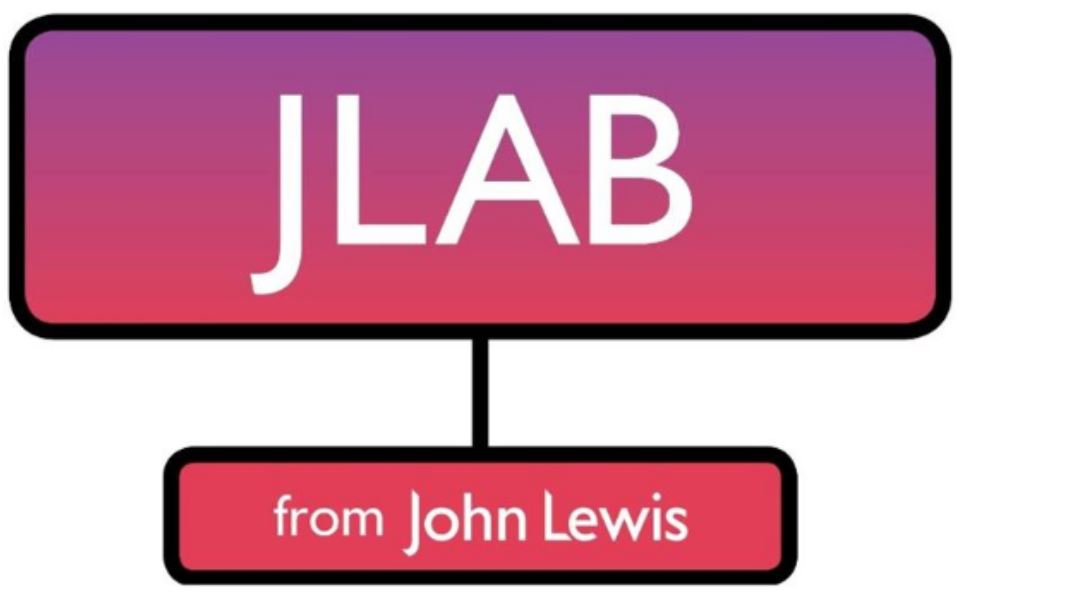
WHAT IS JLAB?
JLAB is British retailer John Lewis’s accelerator program. It was founded in 2014 in partnership with L Marks, a corporate innovation specialist and technology investment fund. This year’s program began on July 4, and during the fourth week of the program, we were invited to visit the John Lewis head office to meet the leaders of the participating startups. Five finalists are enrolled in the 12-week program, which culminates in an investment of up to £100,000 (US$131,815).
One of the most notable changes JLAB has made since the first accelerator program in 2014 is in the funding given to startups. Previously, each startup was given £12,500 (US$16,477) to develop its business idea during the 12-week journey. Now, instead of receiving funding at the beginning of the program, each startup is eligible for an investment of up to £100,000 in exchange for equity in the company. The investment offer will be tailored to each finalist depending on the stage of its business.
The L Marks team told us it had learned that many of the previous startup participants did not need the initial funding given to them. So, now, the program places greater focus on mentoring these high-quality teams and nurturing relationships between them and their clients.
This year’s five JLAB finalists represent four different categories:
- Simplify My Life
- Tech for Kids
- Surprise Us
- Effortless Shopping
Here, we profile the startups and list key takeaways based on our meetings with their leaders and the L Marks team. We then profile the previous years’ winners of the JLAB program.
SIMPLIFY MY LIFE: DIGITALBRIDGE

DigitalBridge is a computer vision company that provides a platform for users to visualize how different kinds of home décor, such as wallpaper, carpet, paint, artwork and furniture, will look in their own home. Users can see on their phone or tablet how different brands’ and retailers’ products will look in the rooms in their home.

Source: DigitalBridge
Here is how DigitalBridge works:
- When customers browse a retailer’s website via a smartphone or a tablet, they simply take a picture of the space in which they would like to visualize products.
- Once they have taken the picture, they can see, in 3D, how furniture, wallpaper, paint, carpet and artwork would look and fit in that space.
- Customers can share the images on their Facebook account for their friends to like, share and engage with. When Facebook friends click on the post, they are directed to the retailer’s website, where they can leave comments or complete a redesign of the original image.
- Customers can purchase products directly through the platform.
We spoke with DigitalBridge CEO David Levine about the challenges the company has faced while developing its web-based service. Levine told us that it has taken three years to develop the technology to generate 3D visualizations from 2D images—an issue many others have also tried to solve.
Unlike many other visualization platforms, DigitalBridge is not app based, but web based. The service will be integrated into each partner retailer’s e-commerce site, so customers will not have to download or install a separate app on their smartphone or tablet.
Customers are more likely to buy home interior products if they are able see how those products will look in their home, Levine said. According to a YouGov poll, 21% of UK customers surveyed said they would buy directly online if they could visualize how products would look at home, while 38% said they would be more likely to buy home décor and furniture in-store if they used retailers’ online and mobile apps.
The company’s business model relies on taking a fee for each transaction made at client retailers’ online stores. After launching in the UK, the company aims to expand its service to Germany, other European countries and the US. For the time being, DigitalBridge targets its service to home design and home improvement retailers, rather than targeting sectors such as fashion, as the company believes that there is an “imagination gap” in interior design. With further developments in the coming years, DigitalBridge’s computer vision software could be used with virtual reality and wearable technology.
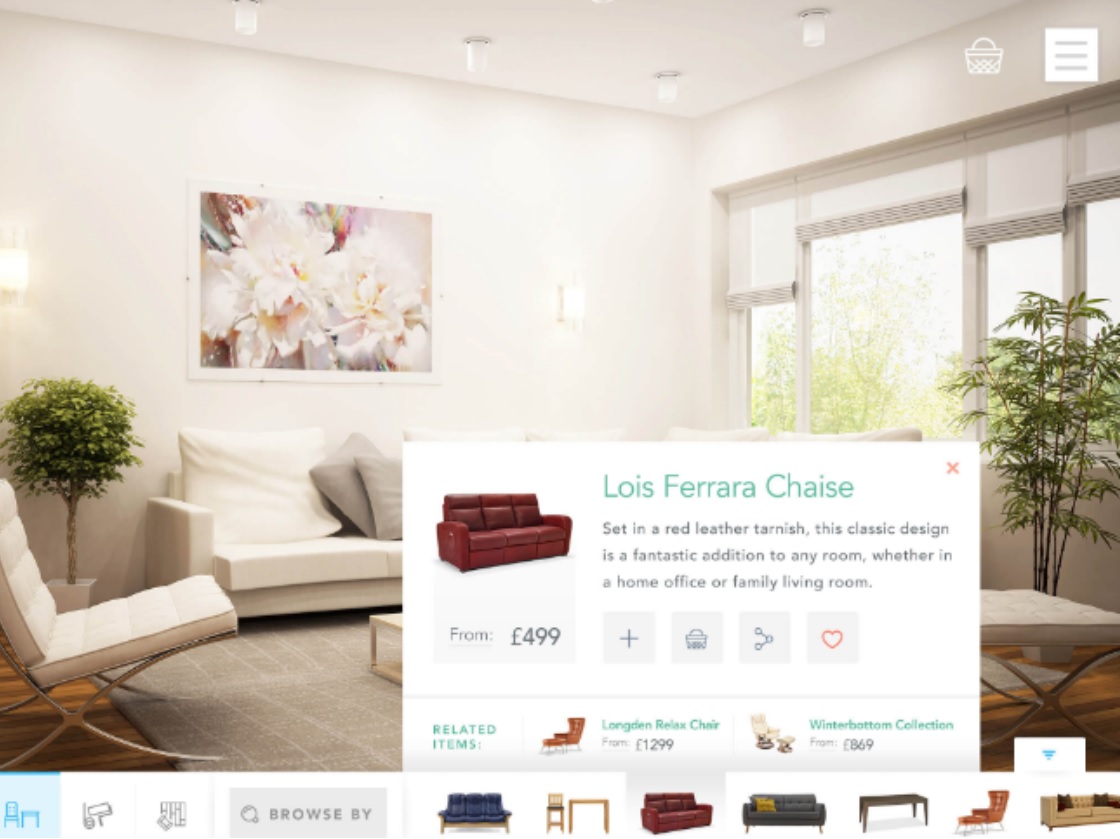
TECH FOR KIDS: ROBOTICAL

Robotical’s educational robots for kids are designed to be usable from the later stages of primary school right through to college. The robots are meant to encourage kids to learn about programming, mechanical engineering, electronics, sensors, 3D printing and more.
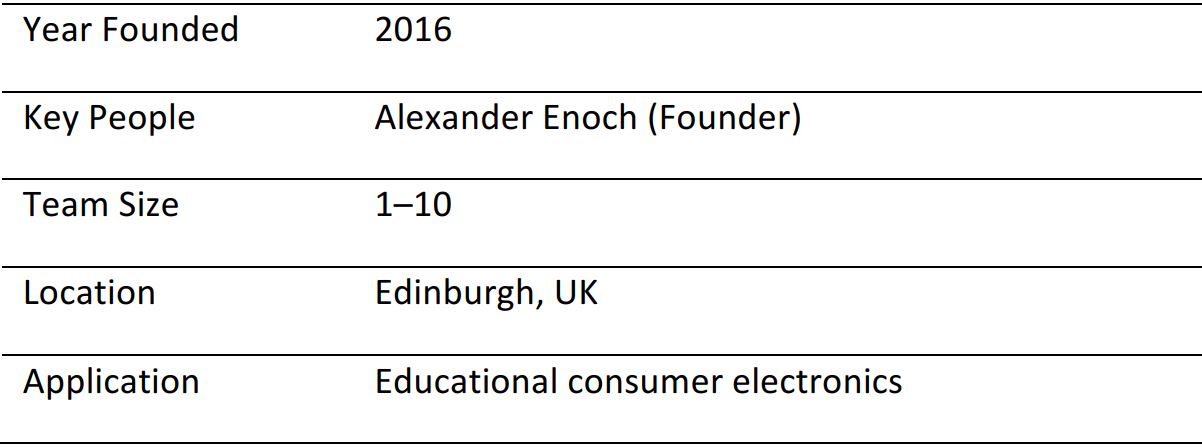
Robotical Founder Alexander Enoch has a PhD in robotics. He told us that he was inspired to start the business when he discovered that there are not many educational, engaging and low-cost toy robotics on the market. Robotical’s first product is called Marty, and it is a fully programmable, Wi-Fienabled walking robot.
Here is how Marty works:
- The parts come in a kit, and kids can put the robot together without any special tools.
- The robot can be controlled remotely via downloadable apps.
- Marty can be programmed for different functions, such playing soccer.

Enoch said that there is great potential and significant demand for educational robots. According to market measurement firm Tractica, toy and educational robot shipments will increase from 2.3 million in 2015 to 11.9 million by 2020.
A number of governmental programs are boosting awareness about robotics and learning to compute though devices. In March 2016, approximately 1 million year-seven students (11- and 12-year-olds) in the UK were given a fully programmable BBC micro:bit computer as part of an effort to encourage them to learn coding. Enoch also mentioned that the Indian government is introducing robotics in schools as part of science, technology, engineering and mathematics (STEM) learning.
Although Robotical is mainly targeting consumers, the company is also hoping to sell to educational institutions. Currently, Robotical is preselling Marty, and it aims to start shipping the robot in January 2017. The starting price for the first edition of Marty is £85 (US$112). Enoch said that the company hopes to introduce additional services once the product has launched. Robotical projects it will sell 1,000 units of Marty in the first year, 4,000 in the second year and 16,000 in the third year.
Robotical will initially start selling Marty in the UK, but the company hopes to expand internationally in the coming years. Enoch noted that the US is by far the biggest market for consumer robotics, and that demand continues to grow in the country. The company is also eyeing Asian markets, including Singapore and India.
Some electronic learning products for children have faced criticism after being hacked; in some cases, private data have been breached. Enoch said that, because Marty does not have a microphone or a camera, and is not linked to a website, security risks are very low.

SURPRISE US: DING LABS

Ding Labs’ smart doorbell allows users to talk with the person at their door from wherever they are in the world. The Ding doorbell alerts users that they have a visitor via their smartphone.
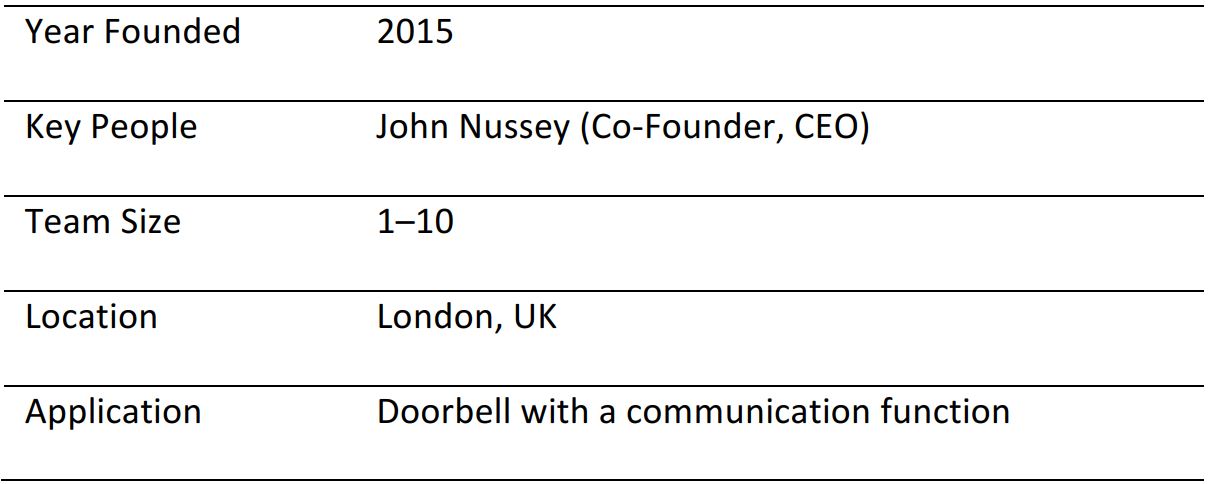
We met John Nussey, Co-Founder and CEO of Ding Labs, who told us how the company’s product differs from other smart doorbells.
Here is how Ding works:
- The user replaces an existing doorbell with a Ding doorbell.
- When the doorbell is pressed, a chime sounds in the user’s home.
- The chime also connects to the home’s Wi-Fi, which it relies on to call the user’s mobile phone.
- When the phone rings, the user can talk with the person at the front door.
Nussey has a design background, and his inspiration for Ding came from personal experience. He had been looking for a reasonably priced smart doorbell with a design element, but found that there was no such product on the market.
Nussey said that many existing smart doorbells come with a surveillance system function and that they often are installed with cameras to monitor the user’s premises. Ding Labs’ core distinction is that its products are not driven by technology and security, but by design, user experience and communication. Nussey noted that he did not want Ding to be too feature-rich and security-focused.
Nussey also found that there is a significant price gap between ordinary doorbells, which are typically priced at £10–£60 (US$13–US$79), and most smart doorbells, which run £150–£300 (US$197–US$395). Ding will cost less than £100 (US$132) per unit, including basic services such as messaging and voice calls to a smartphone. Premium services, such as an answering machine and calls to non-smartphones, will be available with a monthly premium charge.
Nussey noted that the market in the US is significantly ahead of that in the UK, and that the company is still considering where to launch the product. Eventually, the company hopes to expand worldwide, and potentially develop other everyday items.
The Ding is targeted to homeowners, but the company also sees potential to market the product to Airbnb hosts and courier and delivery companies.
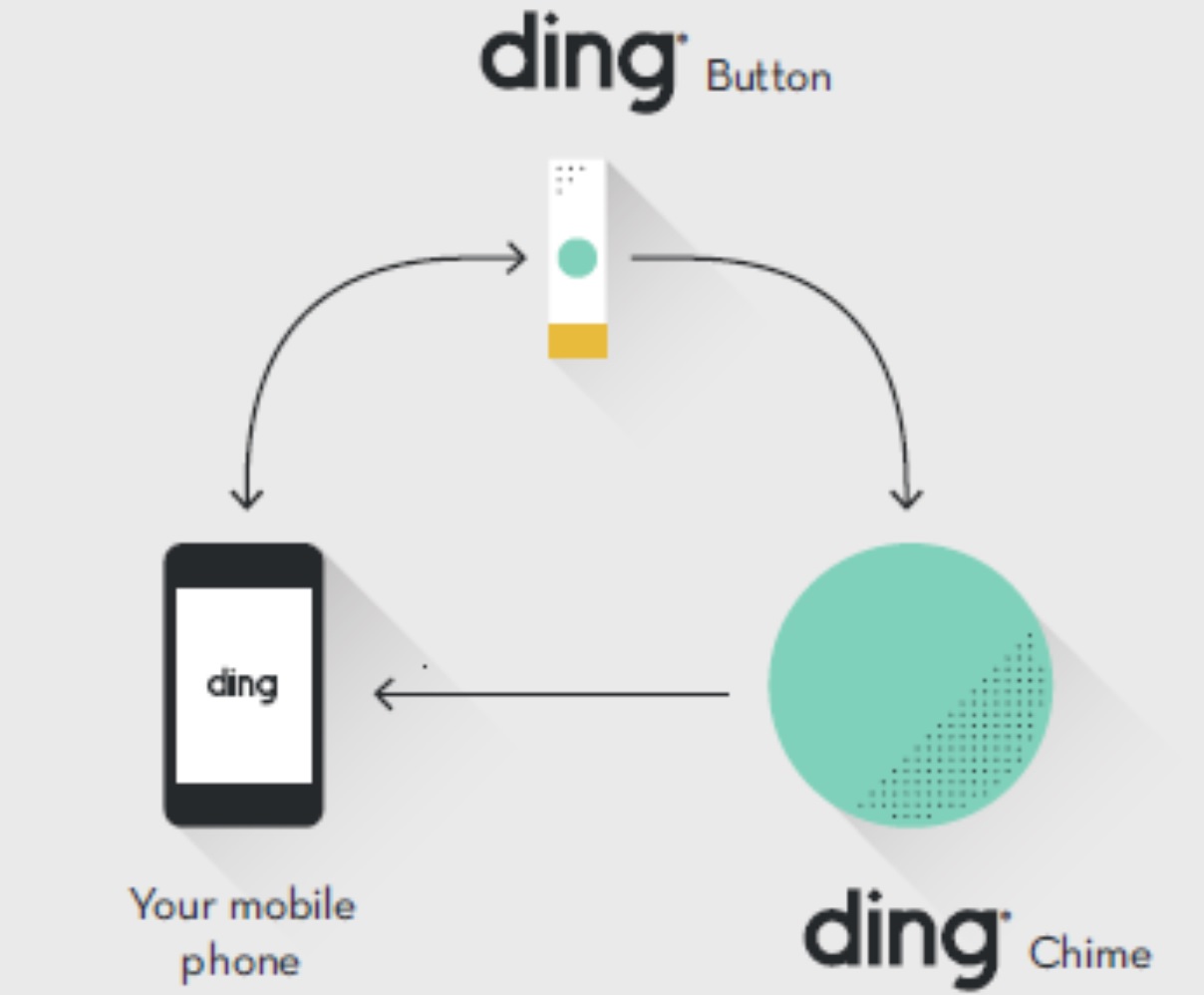
Source: Ding Labs
EFFORTLESS SHOPPING: LINK BIG

Link Big is an automatic tool that enables brands and retailers to sell products directly from their Instagram profile.

Nadav Raviv, Founder and CEO of Link Big, said that the company’s core business model is to “make Instagram shoppable.” He said that, currently, there is an average 40% drop-off on every click a user makes when trying to buy a product on Instagram.
Link Big offers retailers and other businesses a “bio link” that they can insert on their Instagram profile, allowing users to directly buy the item they see without having to search for the product on the brand’s home page.
Raviv emphasized the power of Instagram in turning followers into customers. According to a survey by marketing company Yotpo, 30% of shoppers have purchased a product they discovered on Instagram. Raviv also noted that Instagram has a high shopping referral rate. The key reason the company decided to provide a solution solely for Instagram, though, is that Instagram poses a problem for consumers that other social media platforms do not, as products shown on those platforms are easily buyable.
Raviv said that, with Link Big’s solution, the click-through rate can increase to 6%, compared to the 1.5% rate that the average Instagram advertisement generates.
Currently, the majority of Link Big’s clients are retailers, but the service can be tailored across industries. Raviv mentioned that Link Big can be integrated with publishers’ Instagram profiles, allowing users to click on a specific article they have seen on their Instagram feed.
The company currently has approximately 60 clients in Israel and other countries. After JLAB, the company aims to expand to the US, and Raviv said that he sees major potential for growth in Asia—particularly in China.
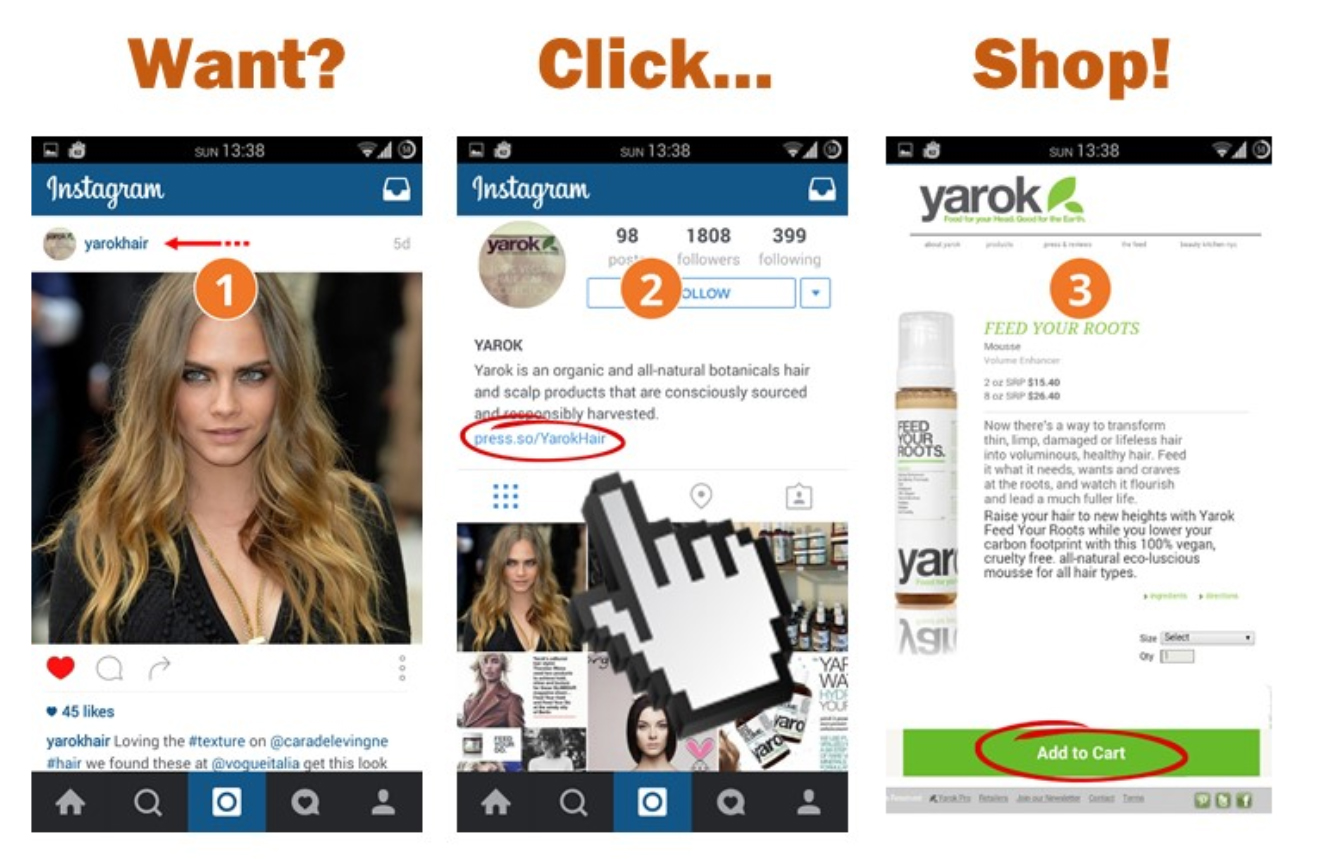
Source: Link Big
SIMPLIFY MY LIFE: WEDDING PLANNER

Wedding Planner is an online wedding-planning platform where users can check suppliers’ prices, availability and recommendations. Couples can also use the platform to create free wedding-planning tools, including a guest list tracker and budget calculator.

Robin Weil, the CEO of Wedding Planner, told us that he got the inspiration for the company after working at a music agency. He said he went to some 300 events a year, 70% of which were weddings, and that he saw a gap in the market for a transparent online platform serving couples who are planning a wedding.
Wedding Planner claims to be the only website in the UK where users can view and compare suppliers’ prices and availability across the country. Weil mentioned that some other wedding websites can be overwhelming, whereas Wedding Planner was designed to be an easy-to-use platform that provides customers with a sufficient number of selected and trusted wedding suppliers. Currently, more than 1,000 suppliers offer wedding products and services on the platform, across categories.
The company makes money based on click-throughs from the website to the suppliers’ websites. Wedding Planner itself does not deal with product returns or other issues; it only serves as a platform for introducing couples to wedding suppliers.
The average customer on Wedding Planner is a do-it-yourself-type bride who shops on the high street and has a wedding budget of £15,000–£20,000 (US$19,772–US$26,363).
Weil said that the wedding industry is rather stable, and even recession-proof. He noted that engaged couples, many of which are millennials, put greater emphasis on experiences on their wedding day. He also mentioned that the recent legalization of same-sex marriages in the UK could boost the market.
Initially, Weil hopes Wedding Planner will become a household name in the UK. He hopes to expand internationally to the Nordic countries, where the wedding sector is growing, and to Germany. Eventually, Weil hopes Wedding Planner will become the market-leading online platform for wedding suppliers in Europe.
One potential area for future growth is expansion into different events, Weil said. Since weddings are one-off events, getting customers to return to the online platform and remain as customers can be difficult.

Source: Wedding Planner
PROFILING PREVIOUS JLAB WINNERS

Finally, we turn to the previous winners of the JLAB program, to profile their offerings and assess how they have progressed.
JLAB WINNER 2014: LOCALZ
Founded in Australia, microlocation tool Localz won the first JLAB in 2014 with its click-and-collect solution.
We spoke with Martijn Verbree, the company’s Director of Europe, to discuss how Localz has evolved since JLAB. The company’s microlocation technology was initially trialed for two weeks in early 2015 in the Peter Jones department store in Sloane Square, London, and then in John Lewis department stores in Brent Cross and Croydon for four months over the busy Christmas period.
Here is how Localz Click & Collect works:
- A customer makes a purchase online, and chooses to collect it in-store.
- When the customer is close to the store, he or she receives a notification asking about pickup.
- If the customer says he or she is ready to pick up the purchase, the staff at the store receives a notification, and ensures that the parcel is ready for pickup by the time the customer gets there.
Localz reduced the waiting times for customers collecting orders at John Lewis, leaving shoppers more time to shop. The solution also improved staff efficiency.
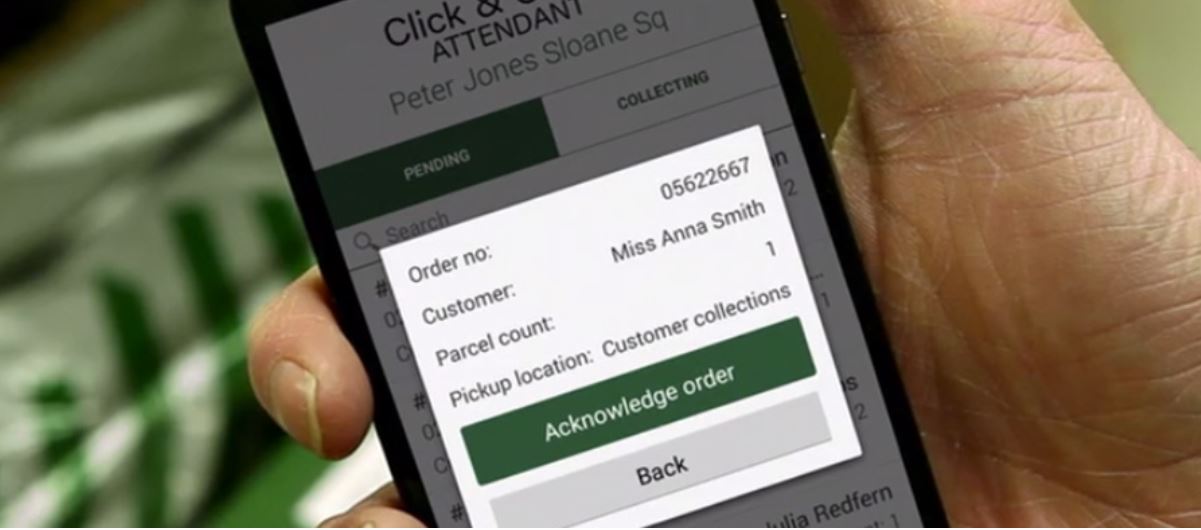
Source: Localz
Localz gained credibility and international exposure in the enterprise market as a result of winning JLAB. In 2015, it also won IBM SmartCamp Australia and took part in PayPal’s Start Tank program. IBM SmartCamp is part of a global entrepreneur program for early-stage companies that enables them to receive mentoring from industry experts and pitch for a chance to win hosting and mentoring support from IBM. Start Tank is an accelerator program supported by PayPal. Startups in the program are given office space and access to mentors and executives from PayPal, Braintree and external advisors. Localz stayed at Start Tank for two six-month cycles. Since then, it has opened its first international office, in London.
The UK is currently the Australian-based company’s core market, but it is eyeing international expansion, particularly in continental Europe and the US. Verbree mentioned that UK retailers are ahead of the game in adopting click-and-collect solutions, compared with retailers in Australia and the US.
Although Australia is a small market with a limited amount of business opportunities, Verbree said that Australians are keen to explore innovations, and that the company has trialed a number of solutions with companies from different sectors in the country:
- Australian retailer Woolworths deployed Localz’s click-and-collect solution, and was able to make its collection service 30% more efficient, 35% cheaper and 50% faster.
- Homepass is a real estate website and app that works with Localz. Through Homepass, a sign on a particular property is activated with a beacon, allowing registered customers to receive information on the property when they are nearby and check themselves in for viewings and auctions. Homepass also gives property agents access to prospective buyer information. The company was recently sold to the Domain Group.
Verbree said that the company is also working with firms in sectors ranging from logistics to medical institutions to develop microlocation solutions.
Apart from click-and-collect, Localz also provides last-mile delivery solutions. In the UK, parcel delivery company DPD uses the Localz Last Mile service in its successful Your DPD app to track deliveries and enable delivery drivers to check that a customer is at the provided delivery address before they reach the destination. According to Localz, failed deliveries are a significant cost to delivery companies, especially as a growing number of parcels are being delivered by retailers.
JLAB WINNER 2015: PEEPLE

The winner of JLAB 2015, Peeple, is a Wi-Fi-connected smart camera that attaches to existing peepholes on front doors, allowing users to see on their smartphones when packages and people arrive at their home.
Here is how Peeple works:
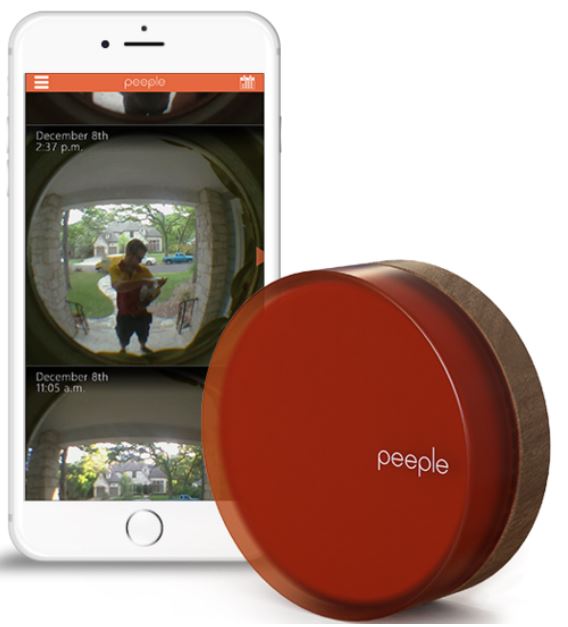
- The user unscrews an existing peephole, slides the Peeple bracket on and then screws it back onto the door.
- The device connects to the home’s existing Wi-Fi and stores data securely in the cloud.
- Users download the free Peeple app, which lets them control how and when they are notified about the activity at their door.
- The device is optimized to use very little power and, under normal use, should only need to be charged a few times a year.
According to L Marks, Peeple, which is headquartered in Austin, Texas, is launching its product soon. As of July 2016, Peeple can be preordered for $149, and shipping is expected to start this autumn.


 DigitalBridge is a computer vision company that provides a platform for users to visualize how different kinds of home décor, such as wallpaper, carpet, paint, artwork and furniture, will look in their own home. Users can see on their phone or tablet how different brands’ and retailers’ products will look in the rooms in their home.
DigitalBridge is a computer vision company that provides a platform for users to visualize how different kinds of home décor, such as wallpaper, carpet, paint, artwork and furniture, will look in their own home. Users can see on their phone or tablet how different brands’ and retailers’ products will look in the rooms in their home.


 Robotical’s educational robots for kids are designed to be usable from the later stages of primary school right through to college. The robots are meant to encourage kids to learn about programming, mechanical engineering, electronics, sensors, 3D printing and more.
Robotical’s educational robots for kids are designed to be usable from the later stages of primary school right through to college. The robots are meant to encourage kids to learn about programming, mechanical engineering, electronics, sensors, 3D printing and more.
 Robotical Founder Alexander Enoch has a PhD in robotics. He told us that he was inspired to start the business when he discovered that there are not many educational, engaging and low-cost toy robotics on the market. Robotical’s first product is called Marty, and it is a fully programmable, Wi-Fienabled walking robot.
Here is how Marty works:
Robotical Founder Alexander Enoch has a PhD in robotics. He told us that he was inspired to start the business when he discovered that there are not many educational, engaging and low-cost toy robotics on the market. Robotical’s first product is called Marty, and it is a fully programmable, Wi-Fienabled walking robot.
Here is how Marty works:
 Enoch said that there is great potential and significant demand for educational robots. According to market measurement firm Tractica, toy and educational robot shipments will increase from 2.3 million in 2015 to 11.9 million by 2020.
A number of governmental programs are boosting awareness about robotics and learning to compute though devices. In March 2016, approximately 1 million year-seven students (11- and 12-year-olds) in the UK were given a fully programmable BBC micro:bit computer as part of an effort to encourage them to learn coding. Enoch also mentioned that the Indian government is introducing robotics in schools as part of science, technology, engineering and mathematics (STEM) learning.
Although Robotical is mainly targeting consumers, the company is also hoping to sell to educational institutions. Currently, Robotical is preselling Marty, and it aims to start shipping the robot in January 2017. The starting price for the first edition of Marty is £85 (US$112). Enoch said that the company hopes to introduce additional services once the product has launched. Robotical projects it will sell 1,000 units of Marty in the first year, 4,000 in the second year and 16,000 in the third year.
Robotical will initially start selling Marty in the UK, but the company hopes to expand internationally in the coming years. Enoch noted that the US is by far the biggest market for consumer robotics, and that demand continues to grow in the country. The company is also eyeing Asian markets, including Singapore and India.
Some electronic learning products for children have faced criticism after being hacked; in some cases, private data have been breached. Enoch said that, because Marty does not have a microphone or a camera, and is not linked to a website, security risks are very low.
Enoch said that there is great potential and significant demand for educational robots. According to market measurement firm Tractica, toy and educational robot shipments will increase from 2.3 million in 2015 to 11.9 million by 2020.
A number of governmental programs are boosting awareness about robotics and learning to compute though devices. In March 2016, approximately 1 million year-seven students (11- and 12-year-olds) in the UK were given a fully programmable BBC micro:bit computer as part of an effort to encourage them to learn coding. Enoch also mentioned that the Indian government is introducing robotics in schools as part of science, technology, engineering and mathematics (STEM) learning.
Although Robotical is mainly targeting consumers, the company is also hoping to sell to educational institutions. Currently, Robotical is preselling Marty, and it aims to start shipping the robot in January 2017. The starting price for the first edition of Marty is £85 (US$112). Enoch said that the company hopes to introduce additional services once the product has launched. Robotical projects it will sell 1,000 units of Marty in the first year, 4,000 in the second year and 16,000 in the third year.
Robotical will initially start selling Marty in the UK, but the company hopes to expand internationally in the coming years. Enoch noted that the US is by far the biggest market for consumer robotics, and that demand continues to grow in the country. The company is also eyeing Asian markets, including Singapore and India.
Some electronic learning products for children have faced criticism after being hacked; in some cases, private data have been breached. Enoch said that, because Marty does not have a microphone or a camera, and is not linked to a website, security risks are very low.

 We met John Nussey, Co-Founder and CEO of Ding Labs, who told us how the company’s product differs from other smart doorbells.
Here is how Ding works:
We met John Nussey, Co-Founder and CEO of Ding Labs, who told us how the company’s product differs from other smart doorbells.
Here is how Ding works:

 Nadav Raviv, Founder and CEO of Link Big, said that the company’s core business model is to “make Instagram shoppable.” He said that, currently, there is an average 40% drop-off on every click a user makes when trying to buy a product on Instagram.
Link Big offers retailers and other businesses a “bio link” that they can insert on their Instagram profile, allowing users to directly buy the item they see without having to search for the product on the brand’s home page.
Raviv emphasized the power of Instagram in turning followers into customers. According to a survey by marketing company Yotpo, 30% of shoppers have purchased a product they discovered on Instagram. Raviv also noted that Instagram has a high shopping referral rate. The key reason the company decided to provide a solution solely for Instagram, though, is that Instagram poses a problem for consumers that other social media platforms do not, as products shown on those platforms are easily buyable.
Raviv said that, with Link Big’s solution, the click-through rate can increase to 6%, compared to the 1.5% rate that the average Instagram advertisement generates.
Currently, the majority of Link Big’s clients are retailers, but the service can be tailored across industries. Raviv mentioned that Link Big can be integrated with publishers’ Instagram profiles, allowing users to click on a specific article they have seen on their Instagram feed.
The company currently has approximately 60 clients in Israel and other countries. After JLAB, the company aims to expand to the US, and Raviv said that he sees major potential for growth in Asia—particularly in China.
Nadav Raviv, Founder and CEO of Link Big, said that the company’s core business model is to “make Instagram shoppable.” He said that, currently, there is an average 40% drop-off on every click a user makes when trying to buy a product on Instagram.
Link Big offers retailers and other businesses a “bio link” that they can insert on their Instagram profile, allowing users to directly buy the item they see without having to search for the product on the brand’s home page.
Raviv emphasized the power of Instagram in turning followers into customers. According to a survey by marketing company Yotpo, 30% of shoppers have purchased a product they discovered on Instagram. Raviv also noted that Instagram has a high shopping referral rate. The key reason the company decided to provide a solution solely for Instagram, though, is that Instagram poses a problem for consumers that other social media platforms do not, as products shown on those platforms are easily buyable.
Raviv said that, with Link Big’s solution, the click-through rate can increase to 6%, compared to the 1.5% rate that the average Instagram advertisement generates.
Currently, the majority of Link Big’s clients are retailers, but the service can be tailored across industries. Raviv mentioned that Link Big can be integrated with publishers’ Instagram profiles, allowing users to click on a specific article they have seen on their Instagram feed.
The company currently has approximately 60 clients in Israel and other countries. After JLAB, the company aims to expand to the US, and Raviv said that he sees major potential for growth in Asia—particularly in China.

 Robin Weil, the CEO of Wedding Planner, told us that he got the inspiration for the company after working at a music agency. He said he went to some 300 events a year, 70% of which were weddings, and that he saw a gap in the market for a transparent online platform serving couples who are planning a wedding.
Wedding Planner claims to be the only website in the UK where users can view and compare suppliers’ prices and availability across the country. Weil mentioned that some other wedding websites can be overwhelming, whereas Wedding Planner was designed to be an easy-to-use platform that provides customers with a sufficient number of selected and trusted wedding suppliers. Currently, more than 1,000 suppliers offer wedding products and services on the platform, across categories.
The company makes money based on click-throughs from the website to the suppliers’ websites. Wedding Planner itself does not deal with product returns or other issues; it only serves as a platform for introducing couples to wedding suppliers.
The average customer on Wedding Planner is a do-it-yourself-type bride who shops on the high street and has a wedding budget of £15,000–£20,000 (US$19,772–US$26,363).
Weil said that the wedding industry is rather stable, and even recession-proof. He noted that engaged couples, many of which are millennials, put greater emphasis on experiences on their wedding day. He also mentioned that the recent legalization of same-sex marriages in the UK could boost the market.
Initially, Weil hopes Wedding Planner will become a household name in the UK. He hopes to expand internationally to the Nordic countries, where the wedding sector is growing, and to Germany. Eventually, Weil hopes Wedding Planner will become the market-leading online platform for wedding suppliers in Europe.
One potential area for future growth is expansion into different events, Weil said. Since weddings are one-off events, getting customers to return to the online platform and remain as customers can be difficult.
Robin Weil, the CEO of Wedding Planner, told us that he got the inspiration for the company after working at a music agency. He said he went to some 300 events a year, 70% of which were weddings, and that he saw a gap in the market for a transparent online platform serving couples who are planning a wedding.
Wedding Planner claims to be the only website in the UK where users can view and compare suppliers’ prices and availability across the country. Weil mentioned that some other wedding websites can be overwhelming, whereas Wedding Planner was designed to be an easy-to-use platform that provides customers with a sufficient number of selected and trusted wedding suppliers. Currently, more than 1,000 suppliers offer wedding products and services on the platform, across categories.
The company makes money based on click-throughs from the website to the suppliers’ websites. Wedding Planner itself does not deal with product returns or other issues; it only serves as a platform for introducing couples to wedding suppliers.
The average customer on Wedding Planner is a do-it-yourself-type bride who shops on the high street and has a wedding budget of £15,000–£20,000 (US$19,772–US$26,363).
Weil said that the wedding industry is rather stable, and even recession-proof. He noted that engaged couples, many of which are millennials, put greater emphasis on experiences on their wedding day. He also mentioned that the recent legalization of same-sex marriages in the UK could boost the market.
Initially, Weil hopes Wedding Planner will become a household name in the UK. He hopes to expand internationally to the Nordic countries, where the wedding sector is growing, and to Germany. Eventually, Weil hopes Wedding Planner will become the market-leading online platform for wedding suppliers in Europe.
One potential area for future growth is expansion into different events, Weil said. Since weddings are one-off events, getting customers to return to the online platform and remain as customers can be difficult.


